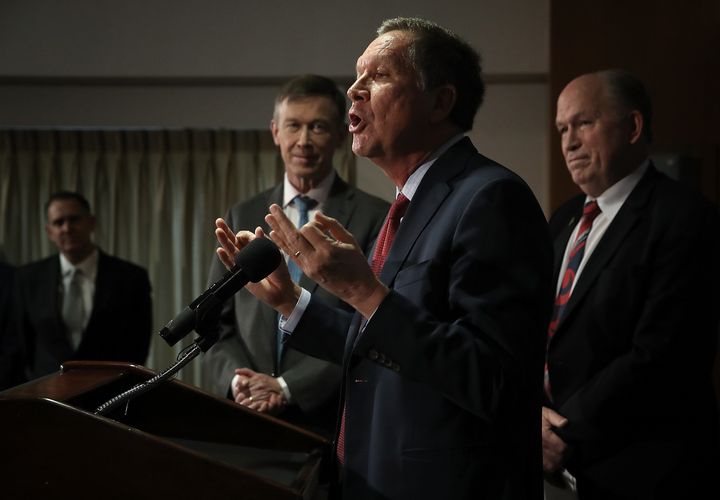
A bipartisan group of governors, including Republican John Kasich of Ohio and Democrat John Hickenlooper of Colorado, joined last week to strongly denounce the federal lawsuit that 20 conservative states filed in February to overturn the Affordable Care Act, or Obamacare. Those states reasoned that because Congress eliminated Obamacare’s individual mandate as part of the Tax Cuts and Jobs Act, the rest of the ACA is now invalid.
The governors were not having it, fearing widespread outrage from their constituents with the elimination of protections for pre-existing conditions. Apparently it’s not a good look for them to watch their own people die in the streets with no access to health care.
From the “skinny repeal,” in which Senate Republicans tried to overturn the individual mandate but keep Obamacare’s Medicaid expansion, to the Graham-Cassidy bill, in which they tried to go further and return control of Medicare to the states, congressional Republicans have failed on multiple occasions to outright repeal Obamacare through legislation. But this latest effort through our nation’s courts represents an underhanded attempt at a sneaky repeal without having the congressional votes or public support for such a drastic and unpopular action.
The individual mandate, which forced individuals to either purchase health insurance or pay a tax penalty, was indisputably the least popular part of the Affordable Care Act. But that’s not the case for many other parts of Obamacare ― particularly the provisions that prevent insurers from discriminating against patients with pre-existing conditions, the rules that allow people to stay on their parents’ insurance policies until they turn 26 and the policies that require insurance companies to cover many preventative care services without additional cost to the patient. In fact, a June 2017 Kaiser Health tracking poll showed that 70 percent of the American public supports keeping the policy on pre-existing conditions in place.
“It’s a backdoor way to repeal Obamacare without having the necessary votes to do so through Congress.”
Given the broad bipartisan support for these more-popular components of Obamacare, the GOP is now using circuitous reasoning to overturn the ACA on very shaky constitutional arguments. Essentially, the crux of their stance is that the individual mandate was such a critical part of the health care law that, without it, everything else must be overturned as well. The lawsuit filing specifically states, “Once the heart of the ACA ― the individual mandate ― is declared unconstitutional, the remainder of the ACA must also fall.”
Andy Slavitt, former acting administrator of the Centers for Medicare and Medicaid Services, wrote in USA Today that “the logic is so tortured and the claims are so weak that the lawsuit is widely considered frivolous,” and many other health and legal experts agree. Conservative legal scholar Jonathan Adler even went into almost math-like detail explaining why the case was so convoluted, stating that “because Congress A claimed this provision (as originally enacted) was an essential component to the broader scheme, plaintiffs claim this still applies to the subsequent revision (even though Congress B didn’t say so), and thereby want the whole statute to go down. That’s just absurd.”
If you are as confused as I was about what Adler was getting at, I don’t blame you. Explaining the logic behind the case is an exercise in mental gymnastics.
To really understand what he said, we must first go back to the landmark 2012 Supreme Court decision in which Chief Justice John Roberts upheld Obamacare by classifying the individual mandate as a tax rather than a penalty. The Supreme Court refused to overturn the individual mandate because it viewed it as an essential component of the health care law. But since Congress later repealed the mandate, the plaintiffs now argue that without that essential component, the whole law is now invalid.
This lawsuit would have likely come and gone without fanfare were it not for the Trump administration’s unusual decision not to defend it. Usually, the current administration defends the current law. But in this case, the Justice Department is siding with the 20 conservative states and even filed a brief in support of the argument that the provision regarding pre-existing conditions should be struck down. It’s a backdoor way to repeal Obamacare without having the necessary votes to do so through Congress.
“Explaining the logic behind the case is an exercise in mental gymnastics.”
With midterm elections coming up, it’s a very risky political move to attempt to repeal the most popular provisions within Obamacare. Perhaps this is the reason the Justice Department is asking the Supreme Court to keep the protections for pre-existing conditions past the midterms and through 2018. But it is both highly deceitful and disingenuous of the administration to trick the electorate and burden them with an unpopular policy change only after midterm elections. It shows that President Donald Trump is more concerned with the irrational need to overturn former President Barack Obama’s signature legislative achievement than he is about the will of the people.
Even more serious than the political ramifications are the health care consequences for millions of Americans. According to an analysis by the Department of Health and Human Services, without the rest of the Obamacare provisions, approximately 133 million Americans have pre-existing conditions that put them at risk of higher premiums or outright denial of coverage. If the protections were to be eliminated, many Americans would be unable to switch jobs without losing their current employer-based coverage. They would then risk being unable to find equivalent replacement coverage due to a pre-existing condition. Perhaps most worrisome of all, many patients with very serious pre-existing conditions ― like cancer, diabetes or heart disease ― may be denied coverage and not have the financial means to receive out-of-pocket care.
Trump once said during his primary campaign that, unlike his Republican rivals, he didn’t want to see Americans dying in the streets with no health care access. Yet this is exactly what would happen with the repeal of Obamacare’s protections for pre-existing conditions. The issue is so dire for millions of Americans from all political stripes and parties that it is no wonder all these governors came together to say that the “administration’s disappointing decision to no longer defend this provision of federal law threatens health care coverage for many in our states with pre-existing conditions and adds uncertainty and higher costs for Americans who purchase their own health insurance.”
It seems almost everyone is in agreement that the rest of Obamacare should remain in place ― save for those who want to do a sneaky repeal through our nation’s courts.
Eugene Gu is a physician-scientist and former Howard Hughes Medical Institute fellow interested in curing congenital heart and kidney diseases in infants. He graduated from Stanford University with honors and earned his medical degree from the Duke University School of Medicine.
